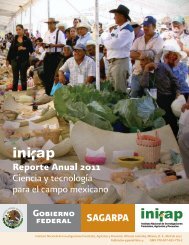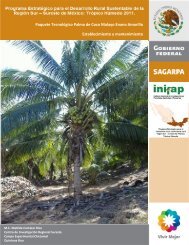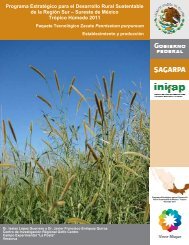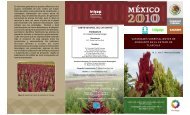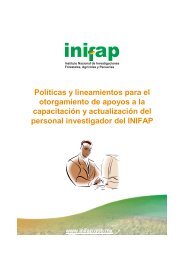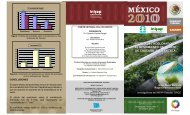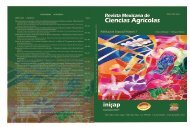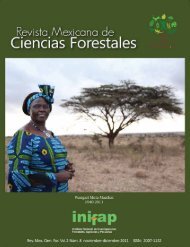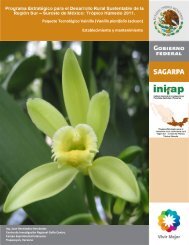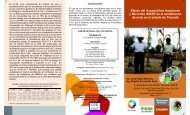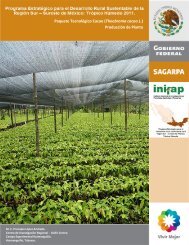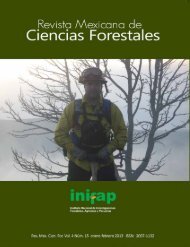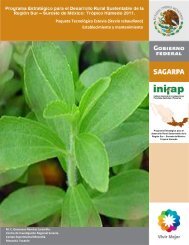Concentración nutrimental en hoja, cáscara y pulpa <strong>de</strong> aguacate cv. ‘Fuerte’ por efecto <strong>de</strong> aspersiones foliares <strong>de</strong> nitrato <strong>de</strong> calcio 295cáscara y pulpa <strong>de</strong>l fruto <strong>de</strong> aguacate cv. ‘Fuerte’, por efecto<strong>de</strong> las concentraciones <strong>de</strong> Ca(NO 3) 2aplicadas en precosechadurante el año <strong>de</strong> aplicación; sin embargo, durante el segundoaño los tratamientos observaron un incremento <strong>de</strong> Ca en cáscaray pulpa, lo que sugiere un efecto residual.LITERATURA CITADABlanke, M. M. and Lovatt, C. J. 1993. Anatomy andtranspiration of the avocado inflorescence. Annals ofBotany 71(6):543-547.Buccheri, M. and Di Vaio, C. 2004. Relationship among seednumber, quality, and calcium content in apple fruits.Journal of Plant Nutrition 27(10):1735-1746.Chapman, H. D. y Pratt, P. F. 1991. Métodos <strong>de</strong> análisis parasuelos, plantas y agua. Editorial Trillas, S. A. <strong>de</strong> C. V.,México, D. F: 195 p.Dilmaghani, M. R.; Malakouti, M. J.; Neilsen, G. H. andFallahi, E. 2004. Interactive effects of potassium andcalcium on K/Ca ratio and its consequences on applefruit quality in calcareous soils of Irán. Journal of PlantNutrition 27(7):1149-1162.Fageria, V. D. 2001. Nutrient interactions in crop plants.Journal of Plant Nutrition 24(8):1269-1290.Himelrick, G. D. and McDuffie, F. R. 1983. The calcium cycle:uptake and distribution in apple trees. HortScience18(2):147-150.Hofman, P. J.; Fuchs, Y. and Milne, D. L. 2002. Harvesting,packing, postharvest technology, transport andprocessing, pp. 363-401. In: The avocado: botany,production and uses. whiley A. W.; Schaffer B. andWolstenholme B. N. (eds). CABI Publishing. NewYork, USA.Kadam, S. S. and Salunkhe, K. D. 1995. Avocado, p. 363-375. In: Handbook of fruit science and technology.Production, composition, storage and processing.Salunke K. D. and Kadam S. S. (eds). Marcel Dekker,Inc. New York, USA.Lahav, E. and Whiley, A. W. 2002. Irrigation and mineralnutrition, pp. 259-297. In: The avocado: botany,production and uses. Whiley, A. W.; Schaffer, B.;Wolstenholme, B. N. (eds). CABI Publishing. NewYork, USA.Marcelle, D. R. 1995. Mineral nutrition and fruit quality. ActaHorticulturae 383:219-226.Marschner, H. 1986. Mineral nutrition of higer plants. SecondEdition. Aca<strong>de</strong>mic Press. San Diego, Calif., USA.889 p.Osuna, G. J. A.; Beltrán, J. A. y Vázquez, V. V. 2005. Efecto <strong>de</strong>l1-metilciclopropeno (1-MCP) sobre el comportamientopostcosecha <strong>de</strong>l aguacate ‘Hass’. Rev. Fitotec. Mex.28(1):1-8.Partridge, C. J.; Pak, H. A. and Brookbanks, P. 2002. Aninvestigation into the effects of preharvest sprays ofcalcium-containing formulations in reducing post-harvestrots in ‘Hass’ avocados. Avocado Growers AssociationAnnual Research Report 2:1-6.Penter, M. G. and Stassen, P. J. C. 2000. The effect of pre- andpostharvest calcium applications on the postharvest qualityof Pinkerton avocado. South African Avocado Growers’Association Yearbook 23:1-7.Pintro, J. C. and Taylor, G. J. 2005. Calcium requirement in thebackground nutrient solution on growth of wheat plantsusing the relative addition rate technique. Journal of PlantNutrition 28:551-565.Salazar-García, S. 2002. Nutrición <strong>de</strong>l aguacate, principiosy aplicaciones. <strong>Instituto</strong> <strong>Nacional</strong> <strong>de</strong> <strong>Investigaciones</strong><strong>Forestales</strong>, Agrícolas y Pecuarias. <strong>Instituto</strong> <strong>de</strong> la Potasa yel Fósforo A. C. D. F., México. 165 p.Sánchez, G. P. y Ramírez, M. P. 2000. Fertilización y nutrición<strong>de</strong>l aguacatero, p. 103-113. In: El aguacate y su manejointegrado. Téliz D. (ed). Mundi Prensa México, S. A. <strong>de</strong>C. V., México, D. F.Saucedo-Hernán<strong>de</strong>z, L.; Martínez-Damián, M. T.; Colinas-León,M. T.; Barrientos-Priego, A. F. y Aguilar-Melchor, J.J. 2005. Aplicaciones foliares <strong>de</strong> nitrato <strong>de</strong> calcio en lamaduración y daños por frío en aguacate ‘Fuerte’. RevistaChapingo Serie Horticultura 11(1):149-157.Solís-Fraire, J. J.; Barrientos-Priego, A. F.; Pérez-Mercado, C.A.; Rubí-Arriaga, M.; Martínez-Damián, M. T. y Reyes-Alemán, J. C. 1998. Aplicaciones foliares <strong>de</strong> nitrato <strong>de</strong>calcio, su efecto en el contenido nutrimental <strong>de</strong> hoja ymesocarpio en aguacatero (Persea americana Mill.) cv.Hass. Revista Chapingo Serie Horticultura 4(2):113-117.Tagliavini, M.; Zavalloni, C.; Rombola, A. D.; Quartieri, M.;Malaguti, D.; Mazzanti, F.; Millard, P. and Marangoni, B.2000. Mineral nutrient partitioning to fruits of <strong>de</strong>ciduoustrees. Acta Horticulturae 512:131-140.Whiley, A. W.; Chapman, K. R. and Saranah, J. B. 1988. Waterloss by floral structures of avocado (Persea americana cv.Fuerte) during flowering. Australian Journal of AgriculturalResearch 39(3):457-467.Willingham, L. S.; Pegg, G. K.; Cooke, W. A.; Coates, M. L.;Langdon, B. P. W. and Dean, R. J. 2001. Rootstockinfluences postharvest anthracnose <strong>de</strong>velopment in‘Hass’ avocado. Australian Journal Agricultural Research52:1017-1022.
Agricultura Técnica en México <strong>Vol</strong>. <strong>34</strong> Núm. 3 Julio-Septiembre 2008 p. 297-302SECADO PARCIAL DE LA RAÍZ DE JITOMATE: EFECTOS EN LA FISIOLOGÍA DE LA PLANTA YCALIDAD DE FRUTO *PARTIAL ROOT DRYING IN TOMATO: EFFECTS ON PLANT PHYSIOLOGY AND FRUIT QUALITYAnselmo López-Ordaz 1§ , Carlos Trejo-López 1 , Cecilia Beatriz Peña-Valdivia 1 , Carlos Ramírez-Ayala 2 , Leonardo Tijerina-Chavez 2y José Alfredo Carrillo-Salazar 31Posgrado en Botánica, Colegio <strong>de</strong> Postgraduados. km 36.5 carretera México-Texcoco. Montecillo, Texcoco, Estado <strong>de</strong> México, 56230. México. 2 Posgrado en Hidrociencias,Colegio <strong>de</strong> Postgraduados. 3 Posgrado en Recursos Genéticos y Productividad, Colegio <strong>de</strong> Postgraduados. § Autor para correspon<strong>de</strong>ncia: anselmomx@yahoo.comRESUMENEl objetivo <strong>de</strong> esta investigación fue estudiar en condiciones<strong>de</strong> hidroponía e inverna<strong>de</strong>ro, los efectos <strong>de</strong> dos niveles <strong>de</strong>humedad aprovechable en el sustrato con plantas <strong>de</strong> jitomate(Lycopersicon esculentum Mill.) sobre característicasfisiológicas y <strong>de</strong> calidad <strong>de</strong>l fruto. La conducción <strong>de</strong> ensayo,realizado en 2003, fue: 21 <strong>de</strong> mayo (siembra), 1° <strong>de</strong> julio(trasplante), 29 <strong>de</strong> julio (inicio <strong>de</strong> los tratamientos), y cosecha<strong>de</strong>l experimento 24 <strong>de</strong> noviembre, respectivamente. Seutilizó la técnica <strong>de</strong> riego seguida <strong>de</strong>l secado parcial <strong>de</strong> laraíz (SPR) para establecer dos tratamientos con diferentecantidad <strong>de</strong> humedad aprovechable en el sustrato, testigo(80-80%) y SPR (80 - 30%). Se <strong>de</strong>terminaron los parámetrosfisiológicos: área foliar, materia seca <strong>de</strong> hoja, tallo, raíz yfruto, relaciones hídricas, e intercambio <strong>de</strong> gases, así comorendimiento y calidad <strong>de</strong> fruto (diámetro, firmeza, sólidossolubles totales, pH y conductividad eléctrica). Las plantascrecieron en contenedores <strong>de</strong> igual volumen con tezontle ycon la raíz dividida en dos partes aplicando dos tratamientos <strong>de</strong>humedad aprovechable en el sustrato: 80-30% (SPR) y 80-80%(testigo). Estos tratamientos se iniciaron 28 días <strong>de</strong>spués <strong>de</strong>ltransplante y se mantuvieron hasta el final <strong>de</strong>l experimento. Losresultados obtenidos indican que el tratamiento SPR no mostródiferencias significativas con respecto al testigo en relacióna los parámetros fisiológicos, sin embargo en las variables <strong>de</strong>calidad <strong>de</strong> fruto como ºBrix, firmeza y conductividad eléctricael SPR provocó un incremento sin afectar el rendimiento.Palabras clave: Lycopersicon sculentum Mill., intercambio<strong>de</strong> gases, relaciones hídricas, sistema <strong>de</strong> raíz dividida.ABSTRACTThe aim of this research was to study un<strong>de</strong>r greenhouse andhydroponic conditions the effects of two levels of wateravailability in the substrate of tomato plants (Lycopersiconesculentum Mill.), upon physiological and quality relatedcharacteristics. The trial was conducted in 2003 as follows:May 21 th , sowing; July 1 st , transplanting; and November24 th , whole plant harvest, respectively. The technique ofirrigation followed by partial root zone drying (PRD) wasused to establish two moisture treatments in the substrate,control (80-80%) and PRD (80-30%). The physiologicalparameters recor<strong>de</strong>d were: leaf area, dry matter weight,plant water relations, and gas exchange, as well as fruityield and quality (diameter, firmness, total soluble solids,pH and electric conductivity). Plants were grown in twoplastic bags filled with “tezontle” (volcanic rock) and theirroot split in two halves and two moisture treatments appliedto the substrate, 80-30% (PRD) and 80-80% (control)).These treatments were applied at 28 days after transplantingand were maintained throughout the experiment. Resultsindicate that PRD and control treatment did not show* Recibido: Agosto <strong>de</strong> 2006Aceptado: Diciembre <strong>de</strong> 2007



